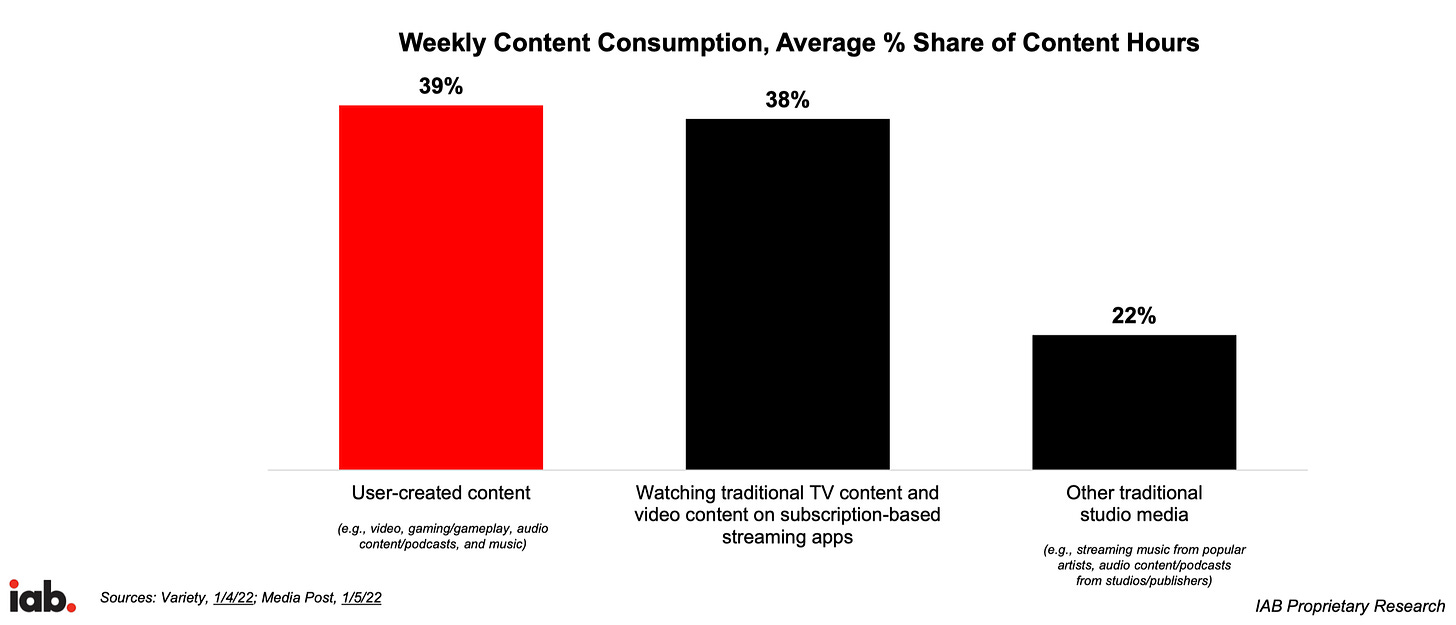2022 is the year creator-based media crossed into the mainstream
Podcasting is still growing and the future looks bright but investments are needed.
Consumption of creator-based media has surpassed traditionally produced media (including streaming services).
I was surprised to see we had crossed this threshold with little fanfare. So many of us have been predicting and talking about this moment since the emergence of digital. But I expect many people have not seen these results as it was somewhat buried inside an IAB report on “Brand Disruption”, released in October of 2022. And I only recently stumbled across it.
In this report, the IAB appears to refer to “creator” and “user” content as synonymous. It also makes the distinction between “user-created” and “professionally produced” content in an attempt to simplify references to traditional TV content that includes subscription and digital streaming channels like Netflix. And while my hackles go up at the inference that creator-based media is never professionally produced, I get the challenge the IAB faced in how to differentiate high-budget content from that which is created by influencers and independent creators.
I think it’s important to recognize that the line between how media is funded and created is no longer an easy one to draw.
Rooster Teeth’s first claim to fame was Red vs. Blue, a web-series parody of video game tropes that grew out of one of the founder’s gameplays of the video game franchise Halo with voiceovers of the characters added in. Today they have more than 45 million subscribers, 5 million unique weekly viewers, podcasts and more. They are now a part of WarnerMedia so we might consider them to be a part of traditional media, but their approach to budgets and show-creation has always been anything but traditional.
In 2014, a group of voice-over artists agreed to take their role-playing game they had been playing in each other’s living rooms and stream it on the Geek & Sundry Twitch channel and Critical Role was born. Today, Critical Role has over 2 million subscribers on YouTube and a data leak suggests they have been the top earners on Twitch. They now have their own production company, foundation, publishing house, and more. And the word is out that they are actively developing and releasing new shows in a variety of formats. Critical Role showed that listeners were more than willing to consume multi-hour-long live play podcasts. How do we classify this creator-based empire?
Lemonada launched in 2019 as an audio-first podcast network with a mission "to make life suck less.” They broke new ground by bringing the reality television format to the podcasting space. And I would say that they are leading innovators in bringing new voices and listeners to audio while also setting a very high bar for storytelling and post-production. With an $8 million seed raise under their belts, I expect Lemonada is far from done in their expansion efforts. And I am excited to see what they do next.
The days of media being defined by whether or not a few large studios are involved are hopefully over. Regardless, let’s get back to the core of the story.
I propose that we have crossed the line where consumption of creator-based media is now a mainstream activity.
Only not everyone in the industry has caught up with consumers. There are still many marketers, executives, producers, venture capitalists, journalists, and even independent creators who see everything creator-based as “emerging” and “untested”.
“Podcasting needs a concerted industry effort to reintroduce itself to both the public AND to brands – many brand marketers are simply unaware of the advances podcasting technology has made over the last five years, particularly in targeting and measurement,” finds the SoundsProfitable Podcast Opportunity study.
I agree. It is time for us to start educating our associates, buyers, managers, friends, and fellow producers on what is now a reality: creator-based media is here to stay.
Nowhere is this more relevant than in podcasting. Podcast publishing is a creator-based medium in one of its most powerful forms. And these creators are forming their own production companies and networks as they scale, while traditional media continues to expand into podcasting with original, acquired and distribution deal content.
But this isn’t just about the content.
Savvy podcasting companies, networks, and producers must expand their investments into public awareness campaigns and the technology and platforms that are needed to support what has become a mainstream method of consuming media. We can’t continue to pretend we are an emerging medium where measurement doesn’t matter.



